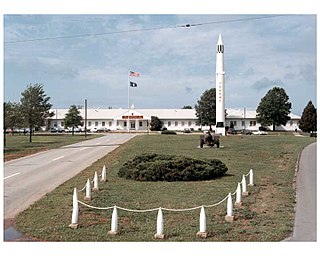
Redstone Arsenal (RSA) is a United States Army post and a census-designated place (CDP) adjacent to Huntsville in Madison County, Alabama, United States and is part of the Huntsville-Decatur Combined Statistical Area. The Arsenal is a garrison for various tenants across the Department of Defense, Department of Justice, and NASA. RSA has benefited from decisions by the Defense Base Realignment and Closure Commission. The Redstone Arsenal CDP had a residential population of 837 as of the 2020 census. The base contains a government and contractor workforce that averages 36,000 to 40,000 personnel daily.

Hawthorne Army Depot (HWAD) is a U.S. Army Joint Munitions Command ammunition storage depot located near the town of Hawthorne in western Nevada in the United States. It is directly south of Walker Lake. The depot covers 147,000 acres (59,000 ha) or 226 sq. mi. and has 600,000 square feet (56,000 m2) storage space in 2,427 bunkers. HWAD is the "World's Largest Depot". It is divided into three ammunition storage and production areas, plus an industrial area housing command headquarters, facilities, engineering shops, etc.
Tooele Army Depot (TEAD) is a United States Army Joint Munitions Command post in Tooele County, Utah. It serves as a storage site for war reserve and training ammunition. The depot stores, issues, receives, renovates, modifies, maintains and demilitarizes conventional munitions. The depot also serves as the National Inventory Control Point for ammunition peculiar equipment, developing, fabricating, modifying, storing and distributing such equipment to all services and other customers worldwide. TEAD provides base support to Deseret Chemical Depot.
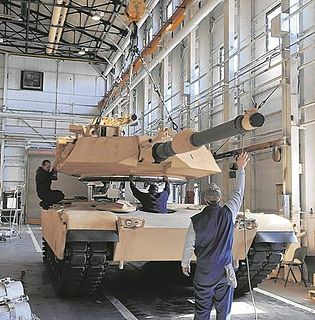
Anniston Army Depot (ANAD) is a major United States Army facility for the production and repair of ground combat vehicles, overhaul of Small Arms Weapon Systems and the storage of chemical weapons, a.k.a. the Anniston Chemical Activity. The depot is located in Bynum, Alabama.
Blue Grass Army Depot (BGAD) is a U.S. Army Joint Munitions Command storage facility for conventional munitions and chemical weapons. The facility is located in east central Kentucky, southeast of the cities of Lexington and Richmond, Kentucky. The 14,494-acre (58.66 km2) site, composed mainly of open fields and wooded areas, is used for munitions storage, repair of general supplies, and the disposal of munitions. The installation is used for the storage of conventional explosive munitions as well as assembled chemical weapons. The depot primarily is involved in industrial and related activities associated with the storage and maintenance of conventional and chemical munitions.
Anniston Chemical Activity was a U.S. Army chemical weapon storage site located in Alabama. The Army had stored approximately seven percent of the nation’s original chemical weapons stockpile at the Anniston Army Depot since the early 1960s. In August 2003, the Army began disposing of these weapons at the Anniston Chemical Agent Disposal Facility. Destruction of the base's stockpile of VX was begun on July 23, 2006. By December 2008, all of the VX on site had been destroyed. Destruction of mustard-filled munitions began on July 2, 2009 after several months of retooling. By July 2010, it had destroyed by incineration 75% of the depot's total stockpile including all 437 tons of GB (sarin) and all VX nerve agent on site. On September 22, 2011, the last mustard gas shells were burned, completing chemical weapons disposal at the facility. The facilities were scheduled for dismantlement by about 2013 and some of the weapon-handling equipment was planned for transfer to the depots at Kentucky and Colorado. Local government emergency departments are expecting to lose millions in annual funding from the federal government related to the presence of the chemical depot and as many as 1000 jobs will be cut on the base.
The Picatinny Arsenal is an American military research and manufacturing facility located on 6,400 acres (26 km2) of land in Jefferson and Rockaway Township in Morris County, New Jersey, United States, encompassing Picatinny Lake and Lake Denmark. The Arsenal is the headquarters of the US Army Combat Capabilities Development Command Armaments Center. It is known for developing the ubiquitous Picatinny rail, as well as being the Army's center of expertise for small arms cartridge ammunition.
Letterkenny Army Depot, the Center of Industrial and Technical Excellence (CITE) for Air Defense and Tactical Missile Systems, was established in 1942. The Depot is under the command structure of the U.S. Army Aviation and Missile Command (AMCOM). The facilities at Letterkenny are used to conduct maintenance, modification, storage, and demilitarization operations on tactical missiles and ammunition.

Naval Surface Warfare Center Crane Division is the principal tenant command located at Naval Support Activity Crane. NSA Crane is a United States Navy installation located approximately 35 miles (56 km) southwest of Bloomington, Indiana, and predominantly located in Martin County, but small parts also extend into Greene and Lawrence counties. It was originally established in 1941 under the Bureau of Ordnance as the Naval Ammunition Depot for the production, testing, and storage of ordnance under the first supplemental Defense Appropriation Act. The base is named after William M. Crane. The base is the third largest naval installation in the world by geographic area and employs approximately 3,300 people. The closest community is the small town of Crane, which lies adjacent to the northwest corner of the facility.
The Defence Explosive Ordnance Disposal, Munitions and Search Training Regiment is an element of the Royal School of Military Engineering responsible for the delivery of training to British Army Ammunition Technicians, Ammunition Technical Officers and Search Operators. The Regiment delivers training from two locations: Marlborough Barracks, MoD Kineton near Kineton, Warwickshire and St George's Barracks, MoD Bicester, near Bicester, Oxfordshire.
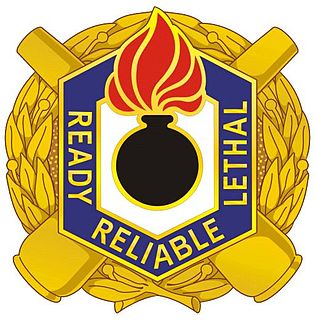
The Joint Munitions Command (JMC) is the latest in a series of commands since World War II that have managed the ammunition plants of the United States. Since 1973, those commands have been headquartered on Rock Island Arsenal. Brigadier General Gavin J. Gardner commands the JMC. The headquarters on Rock Island Arsenal is responsible for munitions production and storage (depots) facilities in 16 states. JMC employs 20 military, over 5800 civilians and 8300 contractor personnel. Of these approximately 14,000 personnel, more than 650 work in the headquarters on Rock Island Arsenal. JMC has an annual budget of 1.2 billion dollars.
Letterkenny Munitions Center, located on Letterkenny Army Depot in Franklin County, Pennsylvania, is a satellite activity under Crane Army Ammunition Activity in Crane, Indiana. The center maintains, stores, and demilitarizes tactical missiles and conventional ammunition for the Army, Air Force and Navy. LEMC assembles, disassembles and tests missiles and missile sections and is also responsible for every aspect of conventional ammunition and missiles to include demilitarization, renovation and X-ray. The facility is part of the US Army Joint Munitions Command.
Milan Army Ammunition Plant (MLAAP) was an ammunition plant of the United States Army Joint Munitions Command near Milan, Tennessee and about 23 miles (37 km) north of Jackson, Tennessee.
Radford Army Ammunition Plant (RFAAP) is an ammunition manufacturing complex for the U.S. military with facilities located in Pulaski and Montgomery Counties, Virginia. The primary mission of the RFAAP is to manufacture propellants and explosives in support of field artillery, air defense, tank, missile, aircraft, and naval weapons systems. As of 2011 RFAAP is operated by BAE Systems under contract to the US Army Joint Munitions Command. The current Commander for the Radford Army Ammunition Plant (RAAP) is LTC Russell A. Jones.
Crane Army Ammunition Activity (CAAA) in Crane, Indiana produces and provides conventional munitions requirements in support of United States Army and Joint Force readiness. It is one of 17 installations of the Joint Munitions Command and one of 23 organic industrial bases under the U.S. Army Materiel Command, which include arsenals, depots, activities and ammunition plants. Established in October 1977, it is located on Naval Support Activity Crane.
McAlester Army Ammunition Plant (MCAAP) is a weapons manufacturing facility for the United States Department of Defense in McAlester, Oklahoma, US. The facility is part of the US Army Joint Munitions Command. Its mission is to produce and renovate conventional ammunition and ammunition related components. The plant stores war reserve and training ammunition. McAlester performs manufacturing, industrial engineering, and production product assurance. The plant also receives, demilitarizes, and disposes of conventional ammunition components. The plant is the largest, in terms of storage, housing close to one-third of the Department of Defense's munitions stockpile.
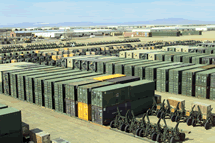
Sierra Army Depot (SIAD) is a United States Army post and military equipment storage facility located near the unincorporated community of Herlong, California. It was built in 1942 as one of several ammunition storage facilities located far enough inland to be safe from Japanese attack, yet close enough to western military posts and ports to facilitate shipment of supplies. The site also met the requirement that the depot be in a dry and isolated area.

Pueblo Depot Activity(PUDA), formerly known as the Pueblo Ordnance Depot and the Pueblo Army Depot, was a U.S. Army ammunition storage and supply facility. Responsibility for the depot fell upon the United States Army Ordnance Corps, and the first civilians were hired in 1942 as operations began. The mission quickly expanded to include general supplies as well. It is a 24,202-acre (97.94 km2) site located 14 miles (23 km) east of Pueblo, Colorado at 38°19′37.07″N104°20′22.4″W. In 1945 they began to receive mass amounts of equipment returning from the combat theaters of World War II. Therefore, the mission expanded yet again to include the maintenance and refurbishing of artillery, fire control, and optical material. In 1951 the depot assumed responsibility to distribute U.S. Air Force ammunition for an eight-state area, as well as storage of strategic and critical materials for the General Services Administration (GSA). They were also tasked to rebuild and provide on-site maintenance support for guided missiles, ensure calibration and maintenance of electronic test equipment and radio-controlled aerial targets. They would also provide specialized training for new Army equipment as needed. In 1952, Rocky Mountain Arsenal in Denver, Colorado transferred chemical agents and chemical munitions to Pueblo Army Depot for secure storage. In 1974 Pueblo Army Depot was redesignated as Pueblo Depot Activity.

The 59th Ordnance Brigade is a military unit of the United States Army. The unit is currently stood up as the U.S. Army Ordnance School's training brigade. In its previous iteration, the brigade had more than 6,500 soldiers. It was responsible for storage, delivering, maintaining, Nuclear and Chemical Control Orders, and supervising the weapons of mass destruction for U.S. Forces and Forces of the Allied NATO-Countries, except France.
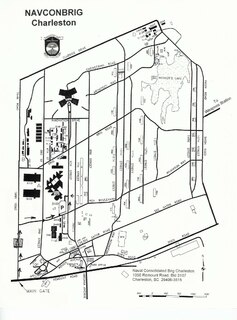
Naval Support Activity Charleston, originally designated Naval Weapons Station Charleston, is a base of the United States Navy located on the west bank of the Cooper River, in the cities of Goose Creek and Hanahan South Carolina. The base encompasses more than 17,000 acres (69 km²) of land with 10,000 acres (40 km²) of forest and wetlands, 16-plus miles of waterfront, four deep-water piers, 38.2 miles (61.5 km) of railroad and 292 miles (470 km) of road. The current workforce numbers more than 11,000 with an additional 3,600 people in on-base family housing.









